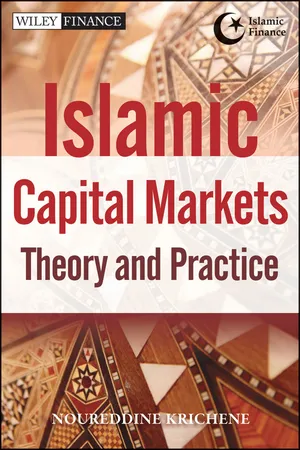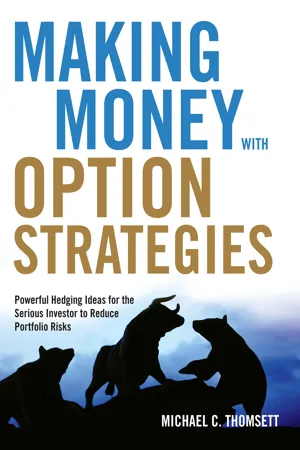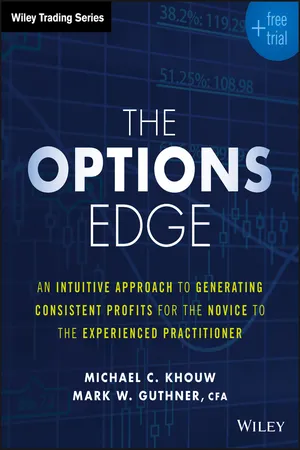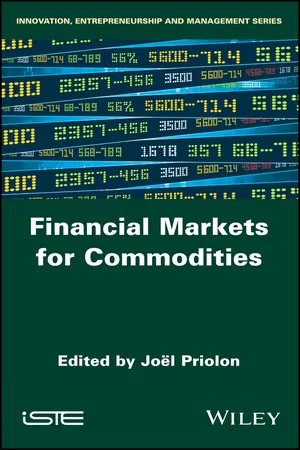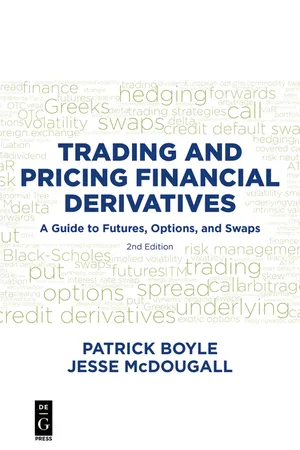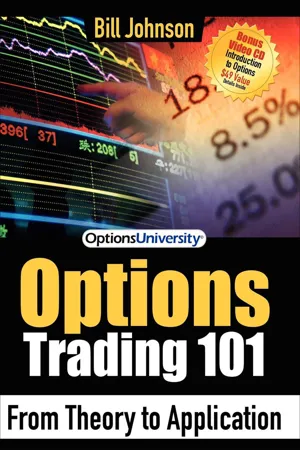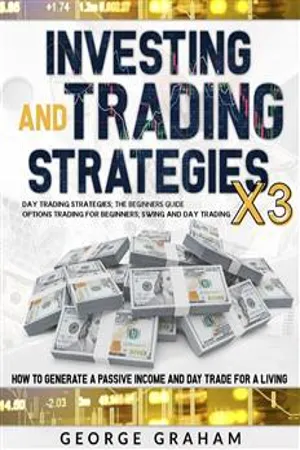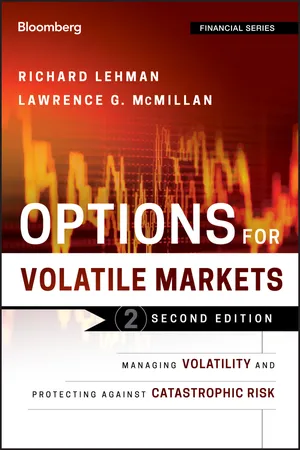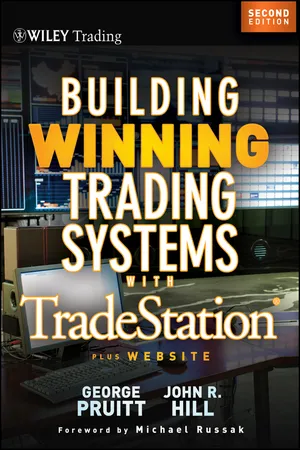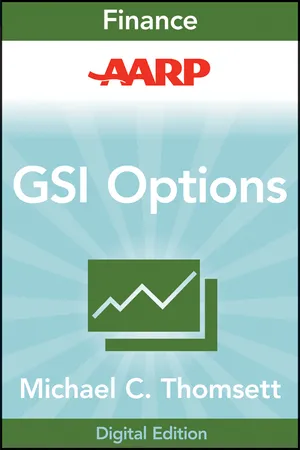Business
Options
Options in business refer to the right, but not the obligation, to buy or sell an asset at a specified price within a set timeframe. They are commonly used for hedging against price fluctuations, speculating on market movements, or as a form of employee compensation. Options can be valuable tools for managing risk and creating strategic investment opportunities.
Written by Perlego with AI-assistance
Related key terms
Related key terms
1 of 4
Related key terms
1 of 3
12 Key excerpts on "Options"
- eBook - ePub
Islamic Capital Markets
Theory and Practice
- Noureddine Krichene(Author)
- 2012(Publication Date)
- Wiley(Publisher)
The importance of Options goes well beyond the profit-motivated trading that is most visible to the public. Today, sophisticated institutional traders use Options to execute extremely complex strategies. For instance, large pension funds and investment banking firms trade Options in conjunction with stock and bond portfolios to control risk and capture additional profits. Corporations use Options to execute their financing strategies and to hedge unwanted risks that they could not avoid in any other way.Options: BASIC DEFINITIONS
An option is a financial security that gives the holder the right to buy or sell an asset at a specified price on or before a specified date. The writer of the option provides insurance to the holder. The writer is obligated to take part in the trade if the holder should so decide.In exchange, the writer receives a fee called the option price. This contrasts with a futures contract where no money is exchanged at the initiation of the contract. A call option allows the holder to buy an asset; a put option allows the holder to sell an asset. The buyer of the option is said to have a long position; the seller of the option is called an option writer and has a short position. An American option can be exercised on or before maturity date. A European option can be exercised only at maturity. An option is characterized by its underlying asset, its strike price K , and its maturity or expiration date T . With financial innovations, many types of Options were invented. There are exchange-traded Options and over the counter Options. Options are written on stocks, futures, indices, commodities, and currencies. There are plain-vanilla Options such as standard calls and puts. There are exotic Options such Asian option and barrier option. There are other types of Options such as embedded option and real option. An option position is said to be naked if it is not hedged. There are four kinds of naked option positions: long call, short call, long put, short put.Call Option Payoff
LetSTdenote the price of the underlying at maturity T . Consider a call option with a strike of K - eBook - ePub
Making Money with Option Strategies
Powerful Hedging Ideas for the Serious Investor to Reduce Portfolio Risks
- Michael C. Thomsett(Author)
- 2016(Publication Date)
- Career Press(Publisher)
1 The Basics of OptionsT he Options market is characterized by specialized jargon and terminology. This chapter explains all of the terms used and places them in context for you, as an investor. Beyond definitions, you also need to grasp the essential trading rules and to be able to read Options listings found online or in the financial press.This chapter presents a broad overview of the Options market as a starting point for folding an Options strategy into an equity portfolio; identifying specific risks; and understanding how to mitigate or remove an equity-based market risk .Attributes of the Option Contract
Options are intangible contracts, granting their buyers specific rights (and imposing obligations on sellers). The amazing attribute of Options is that they can be used in many ways, covering the spectrum from highly speculative to highly conservative. Most investors cannot be classified as strictly speculative or conservative, but tend to operate within a range of risk levels. These levels change based on the circumstances, including market conditions, stock prices, and the amount of cash in a trading account.With these variations in mind, Options are perfect vehicles due to their flexibility. The degree of risk you can undertake based on how you use Options is not fixed any more than your risk tolerance. The leverage of Options is very attractive as well. However, depending on how that leverage is applied, it can increase or decrease your risk.Key Point Options are intangible contracts granting specific rights to their buyers and obligations to their sellers.For example, Options typically cost 3% to 5% of 100 shares of stock. So buying a single option is a highly leveraged way to benefit from favorable stock price movement—or to suffer the risk of unfavorable movement. The percentage of option cost varies due to the specific terms of that option.The flexibility of Options is one of the primary attractions among investors. In addition to the pure speculator, many conservative investors with a buy-and-hold portfolio will trade Options with a small portion of capital, as a form of “side bet” on the market. This not only brings up the chance for added profits, but also allows investors to take advantage of price movement in their stocks. Rather than sell to take profits, Options can be used to capture those profits without giving up stock. And when a stock price is likely to decline, Options can also be used to limit risks. In other words, Options are flexible enough to allow you to manage portfolio risks while continuing to hold stocks in your portfolio. - eBook - ePub
The Options Edge
An Intuitive Approach to Generating Consistent Profits for the Novice to the Experienced Practitioner
- Michael C. Khouw, Mark W. Guthner(Authors)
- 2016(Publication Date)
- Wiley(Publisher)
Chapter 1 What Is an Option, and How Do Options Work?An option is a contract to buy or sell any specific item, which is referred to as the underlying instrument, asset, or interest. As with all contracts, there are two parties involved. An option contract is an agreement that gives the buyer or owner of the contract the opportunity, but not an obligation, to buy or sell the underlying instrument at their discretion. The seller, on the other hand, has the obligation to perform the seller's end of the bargain should the buyer choose to exercise their right to transact under the terms of the agreement.The underlying instrument is commonly a financial instrument like a stock, an index of financial instruments, a basket of stocks such as an ETF, a bond or a currency. The underlying instrument does not have to be a financial instrument, however. An option may reference a physical good such as a commodity (oil, gas, gold, silver or copper) or an economic good such as electricity, water, or real estate, and so on. Since investors are interested in Options as a means of pursuing certain financial and/or risk management objectives in their investment portfolios, this book will focus on Options referencing financial assets, such as stocks and stock indexes. Rest assured that the principles underlying an option contract are universal. It is easy to take the concepts presented and apply them to other aspects of your economic life, be it the purchase or sale of real estate or the management of a business.The terms and conditions of an option contract must be very precise. The contract defines when, how, and at what price the contract will be executed. For Options on financial assets, there are a number of standard terms the buyer and seller must agree upon. Fortunately, Options listed on exchanges have standardized terms. This makes financial Options liquid and easy to trade. Once you know the basic standardized terms of an option contract, you are good to go. Firstly, an option contract will establish the price of a trade, if a transaction were to occur. A transaction only occurs, if and only if, the owner of the option choses to exercise their right to transact. When an owner of an option exercises their right to transact, they make the demand that the seller of the option perform to the terms and conditions of the option contract. When a contract is exercised, the obligation is fulfilled and the contract is terminated. The price at which a trade occurs is known as the strike price. The contract multiplier defines the amount of stock or commodity transacted under the option agreement. For Options on equities, the contract multiplier is typically 100. This means that a single option contract references 100 shares of stock. As a result, when the owner of a call option on a stock exercises their right, the option seller must deliver 100 shares of stock. Options do not last forever. The contract will define the length of time an option will remain effective. Should the buyer choose to exercise their right under the option agreement and transact, the buyer must do so within this window of time. The date upon which an option expires is known as the expiration date - eBook - ePub
- Joel Priolon, Joel Priolon(Authors)
- 2018(Publication Date)
- Wiley-ISTE(Publisher)
5 Options MarketsOptions have seen considerable growth since the 1970s and, today, are among the most widely exchanged financial contracts on markets around the world. The basic principles on which Options are based are easy to understand. However, the pricing of Options is a difficult exercise based on an advanced mathematical corpus. This is why certain technical developments related to this are dicsussed in the Appendix.5.1. The fundamental conceptsAn option is a financial contract that binds the issuer, or writer of the option and the holder of the option, who has acquired the buying rights (option to buy) or the selling rights (option to sell) for certain goods, at a certain date (or over a certain period), at a price fixed in advance. In other words, the holder of an option has the right to buy or sell but has no obligation to exercise this right. When the contract is created, the option writer receives a premium paid by their acquirer. At the time when they commit to an Options contract, the role of the seller and the buyer are unambiguous; but, going forward, the buyer may cede their option without, however, becoming the writer. This is why, in the rest of this chapter and in order to remove certain ambiguities, we will talk of “the writer” and not of the “seller”. Similarly, we will talk of the “holder of the option”, rather than “the buyer”. However, the reader must be aware that in other essays and books, these operators are very often called simply “seller” or “buyer”.
The vocabulary used when talking about Options is quite particular. We have provided, below, a list of the most frequently used terms:5.1.1. Characteristics of Options and a glossary- – call
- eBook - ePub
Trading and Pricing Financial Derivatives
A Guide to Futures, Options, and Swaps
- Patrick Boyle, Jesse McDougall(Authors)
- 2018(Publication Date)
- De|G Press(Publisher)
Chapter 3Introduction to Options
What Is an Option?
An option is a derivative financial instrument that specifies a contract between two parties for a future transaction on an asset at a reference price. The buyer of the option gains the right, but not the obligation, to engage in that transaction, while the seller incurs the corresponding obligation to fulfill the transaction. Options cost money to buy at inception while futures cost nothing to enter into, either as a buyer or as a seller, at inception.There are two basic types of option: calls and puts.Options Contract Specifications
Each financial option is a contract between two counterparties with the terms of the option specified in a term sheet. Some exotic Options may have extremely complicated term sheets, but all contracts usually contain the following specifications:–A description of what the underlying asset is –Whether the option holder has the right to buy or the right to sell the underlying –The quantity and quality, or class, of the underlying asset –The “strike price,” which is the price at which the transaction will occur upon exercise –The expiration date, which is the last date the option can be exercised –Whether the writer must deliver the actual asset on exercise, or may simply tender the equivalent cash amountCall Option
The buyer of a call option has the right, but not the obligation, to buy agreed lots of 100 shares of the option by the expiration, for a certain price: the strike price. The seller (or “writer”) is obligated to sell the commodity or financial instrument should the buyer so decide.The buyer pays a fee, called a premium , for this right.Put Option
The buyer of a put option - eBook - ePub
Options Trading 101
From Theory to Application
- Bill Johnson(Author)
- 2007(Publication Date)
- Morgan James Publishing(Publisher)
Chapter One
Introduction to Options
What Is an Option?
Options are simply legally binding agreements – contracts – between two people to buy and sell stock at a fixed price over a given time period.There are two types of Options: calls and puts . A call option gives the owner the right, not the obligation, to buy stock at a specific price over a given period of time. In other words, it gives you the right to “call” the stock away from another person. A put option, on the other hand, gives the owner the right, not the obligation, to sell stock at a specific price through an expiration date. It gives you the right to “put” the stock back to the owner. Option buyers have rights to either buy stock (with a call) or sell stock (with a put). That means it is the owner’s choice, or option , to do so, and that’s where these assets get their name.Now you’re probably thinking that this is sounding complicated already. But Options are used under different names every day by different industries. For instance, we are willing to bet that you’ve used something very similar to a call option before. Take a look at the following coupon:The way pizza coupons and call Options work is very similar. This pizza coupon gives the holder the right to buy one pizza. It is not an obligation. If you are in possession of this coupon, you are not required to use it. It only represents a right to buy. There is also a fixed price of $10.00. No matter how high the price of pizzas may rise, your purchase price is locked at $10.00 if you should decide to use it. Last, there is a fixed time period, or expiration date , for which the coupon is good.Now let’s go back to our definition of a call option and recall that it represents:1) Right to buy stock2) At a fixed price 3) Over a given time period You can see the similarities between a call option and pizza coupon. If you understand how a simple pizza coupon works, you can understand how call Options work. - eBook - ePub
Investing and trading strategies X3
Day Trading Strategies, Options Trading for Beginners, Swing and Day Trading
- George Graham(Author)
- 2023(Publication Date)
- Youcanprint(Publisher)
CHAPTER 1:What is Options Trading?- What Are Options?
An option is a contract that gives the holder the right to sell or buy an asset at a set price (the strike price) within a given period (the term) but does not obligate the holder into doing so. The strike price may be lower or higher than the current asset price (market price).Like a bond or stock, an option is a tradable security. You can purchase or sell Options to a foreign broker or trade them on an exchange within the United States. An option may give you the opportunity to leverage your cash, though it may be high risk because it eventually expires(expiration date). For stock Options, each option contract represents 100 shares.- The Options Trading Concept
An instance of an option is if you want to buy a car/house, but for whatever reason, do not have immediate cash for it but will get the money next month. The item owner may agree to give you the option to purchase the house in a month for, let us say $250,000 if you pay $2,500 now for the option. Near the expiration of your option, the asset’s value may appreciate perhaps because of the discovery that the house is on a highly valued piece of land.You can now buy the asset at the agreed price and sell it for a profit. The asset's value may also depreciate perhaps when the house develops plumbing problems or other problems or, in the case of a vehicle, gets into an accident. If you decide not to buy the asset and let your purchase option expire, you lose your initial investment, the $2,500 you placed for the option.This is the general concept of how Options trading happens; however, in reality, Options trading is a lot more complex and involves more risks.- Basic Option Trading Terminologies
- eBook - ePub
Options for Volatile Markets
Managing Volatility and Protecting Against Catastrophic Risk
- Richard Lehman, Lawrence G. McMillan(Authors)
- 2011(Publication Date)
- Bloomberg Press(Publisher)
Chapter 1 Option BasicsTo understand and implement option strategies effectively, you need to understand not only how stocks and the equity markets work, but what Options are, how they function, and what affects their value. The strategy discussions in this book assume you are already familiar with stocks and Options, so to refresh you on the basics, we have constructed Chapters 1 and 2 as a review of listed equity Options. If you are already familiar with Options, you can begin reading about call writing in Chapter 3.What Are Options?An option is a contract representing the right, for a specified term, to buy or sell a specified security at a specified price. Like stock, they are also standardized so they can trade on formal securities exchanges and are regulated by the Securities and Exchange Commission (SEC).There are two types of Options: puts and calls.1. Call option: A contract representing the right for a specified term to buy a specified security at a specified price.2. Put option: A contract representing the right for a specified time to sell a specified security at a specified price.The specified price is known as the strike, or exercise, price; the specified term is determined by the option's expiration date; and the specified security is referred to as the underlying security. There are exchange-listed Options on a number of securities and even non-securities (such as indexes), but this book is devoted entirely to those on stocks and exchange-traded funds (ETFs).We may refer to both of these in aggregate as equity Options. - eBook - ePub
Trading Options Greeks
How Time, Volatility, and Other Pricing Factors Drive Profits
- Dan Passarelli(Author)
- 2012(Publication Date)
- Bloomberg Press(Publisher)
PART I
The Basics of Option Greeks
Passage contains an image
CHAPTER 1
The Basics
To understand how Options work, one needs first to understand what an option is. An option is a contract that gives its owner the right to buy or the right to sell a fixed quantity of an underlying security at a specific price within a certain time constraint. There are two types of Options: calls and puts. A call gives the owner of the option the right to buy the underlying security. A put gives the owner of the option the right to sell the underlying security. As in any transaction, there are two parties to an option contract—a buyer and a seller.Contractual Rights and Obligations
The option buyer is the party who owns the right inherent in the contract. The buyer is referred to as having a long position and may also be called the holder, or owner, of the option. The right doesn’t last forever. At some point the option will expire. At expiration, the owner may exercise the right or, if the option has no value to the holder, let it expire without exercising it. But he need not hold the option until expiration. Options are transferable—they can be traded intraday in much the same way as stock is traded. Because it’s uncertain what the underlying stock price of the option will be at expiration, much of the time this right has value before it expires. The uncertainty of stock prices, after all, is the raison d’être of the option market.A long position in an option contract, however, is fundamentally different from a long position in a stock. Owning corporate stock affords the shareholder ownership rights, which may include the right to vote in corporate affairs and the right to receive dividends. Owning an option represents strictly the right either to buy the stock or to sell it, depending on whether it’s a call or a put. Option holders do not receive dividends that would be paid to the shareholders of the underlying stock, nor do they have voting rights. The corporation has no knowledge of the parties to the option contract. The contract is created by the buyer and seller of the option and made available by being listed on an exchange. - George Pruitt, John R. Hill(Authors)
- 2012(Publication Date)
- Wiley(Publisher)
put Options.Nomenclature and Terminology An option is specified by stating its underlying asset, the expiration month, the strike price, and the type (call or put), usually in that order. For example: IBM July 120 calls This would usually refer to Options expiring in July of the present year. If the Options expire more than a year out from the present day, one might need to include a year indication of some kind, for example (with “03” meaning the year 2003): IBM July03 20 callsAlso important is the manner in which Options prices are converted into dollar amounts. Most stock and index Options have a multiplier of 100, meaning that one option is for 100 shares of stock. So, if you were to buy one option at a price of 1.10, for example, you would pay $110. Multipliers for futures-based Options vary from 50 to 500.Long and ShortMost investors understand the concept of being long, whether they realize it or not. When you own something you are said to have a long position in it. As such, when you are long the market, you are taking a position to profit in a rising market.Going short means to sell something, without first owning it, to profit from a falling market. How can you sell something you don't own? In securities trading, going short involves borrowing the securities (usually from your broker) to sell. When you move to close the position at a later date, you buy back the securities, giving the shares back to your broker. With futures and Options, it's even easier. You're entering into an agreement that comes complete with standard contractual rights and obligations. The only difference is that futures and Options afford you the opportunity to get out of the contract at any time by placing a buy or sell order that cancels your position before the obligations come due.Being long or short an option does become more complex because of the two types of Options: calls and puts. When you buy an option, regardless of whether it's a call or put, you are long the option. When you buy a call option, because you stand to benefit from the underlying going up, your position can be considered to be, in a general sense, long the underlying as well. However, when you buy a put option, because you stand to benefit from the underlying going down, you can be considered to be, in a general sense, short the underlying. Table 10.3- eBook - ePub
- Michael C. Thomsett(Author)
- 2011(Publication Date)
- Wiley(Publisher)
Option strategies range from high risk to extremely conservative. The risk features on one end of the spectrum work to your advantage on the other. Options provide you with a rich variety of choices.optionthe right to buy or to sell 100 shares of stock at a specified, fixed price and by a specified date in the future.An option is a contract that provides you with the right to execute a stock transaction—that is, to buy or sell 100 shares of stock. (Each option always refers to a 100-share unit.) This right includes a specific stock and a specific fixed price per share that remains fixed until a specific date in the future. When you have an open option position, you do not have any equity in the stock, and neither do you have any debt position. You have only a contractual right to buy or to sell 100 shares of the stock at the fixed price.Since you can always buy or sell 100 shares at the current market price, you might ask: “Why do I need to purchase an option to gain that right?” The answer is that the option fixes the price of stock, and this is the key to an option’s value. Stock prices may rise or fall, at times significantly. Price movement of the stock is unpredictable, which makes stock market investing interesting and also defines the risk to the market itself. As an option owner, the stock price you can apply to buy or sell 100 shares is frozen for as long as the option remains in effect. So no matter how much price movement takes place, your price is fixed should you decide to purchase or sell 100 shares of that stock. Ultimately, an option’s value is going to be determined by a comparison between the fixed price and the stock’s current market price.A few important restrictions come with Options:round lota lot of 100 shares of stock or of higher numbers divisible by 100, the usual trading unit on the public exchanges.• The right to buy or to sell stock at the fixed price is never indefinite; in fact, time is the most critical factor because the option exists for a specific time only. When the deadline has passed, the option becomes worthless and ceases to exist. Because of this, the option’s value is going to fall as the deadline approaches, and in a predictable manner. - eBook - ePub
Quantum Trading
Using Principles of Modern Physics to Forecast the Financial Markets
- Fabio Oreste(Author)
- 2011(Publication Date)
- Wiley(Publisher)
At the beginning of the twentieth century, the Options markets on stocks was already rich and lively, even though it was just an OTC market, which means it wasn't regulated by an Options exchange. Brokers offered their clients the possibility to buy and sell Options, but unlike today, those Options showed a very strange pricing. Black and Scholes hadn't yet discovered their option pricing models (they weren't even born yet), and so, in the beginning there was a fixed price for both calls and puts. It wasn't important that 15 or 30 days were left until the expiration day of a period: the price was always the same. Option buyers and sellers didn't have any models to understand if an option price was fair or not. They had only a fixed price, which caused fewer problems than the ones experienced by a professional Options trader today.Finally, in 1973, a stock exchange was created in Chicago where many stock Options were listed. Prices were clear and certain, and the transactions were regulated. But at that early stage only call Options were listed. Put Options weren't available yet; traders needed to wait a few years before having the complete option system that we have today. At that time traders used synthetic positions to simulate a put, obtained by selling short the stock, and simultaneously purchasing a call.Options CharacteristicsYou can create an option on whatever is exchanged between different counterparts. If the option's underlying is listed in a regulated market, then the option is a standard contract with an official quotation. You have two kinds of Options: calls and puts. A call buyer purchases the right to take advantage of a rise in the underlying. A put buyer bets on the decline of the option's underlying price.Consequently we will review the definition of an option we already saw at the beginning of the chapter.An equity option is a contract that conveys to its holder the right, but not the obligation, to buy (in the case of a call) or sell (in the case of a put) shares of the underlying security at a specified price (the strike price), on or before a given date (expiration day). After this given date, the option ceases to exist. The seller of an option is, in turn, obligated to sell (in the case of a call) or buy (in the case of a put) the shares to (or from) the buyer of the option at the specified price upon the buyer's request.
Index pages curate the most relevant extracts from our library of academic textbooks. They’ve been created using an in-house natural language model (NLM), each adding context and meaning to key research topics.
Explore more topic indexes
Explore more topic indexes
1 of 6
Explore more topic indexes
1 of 4
